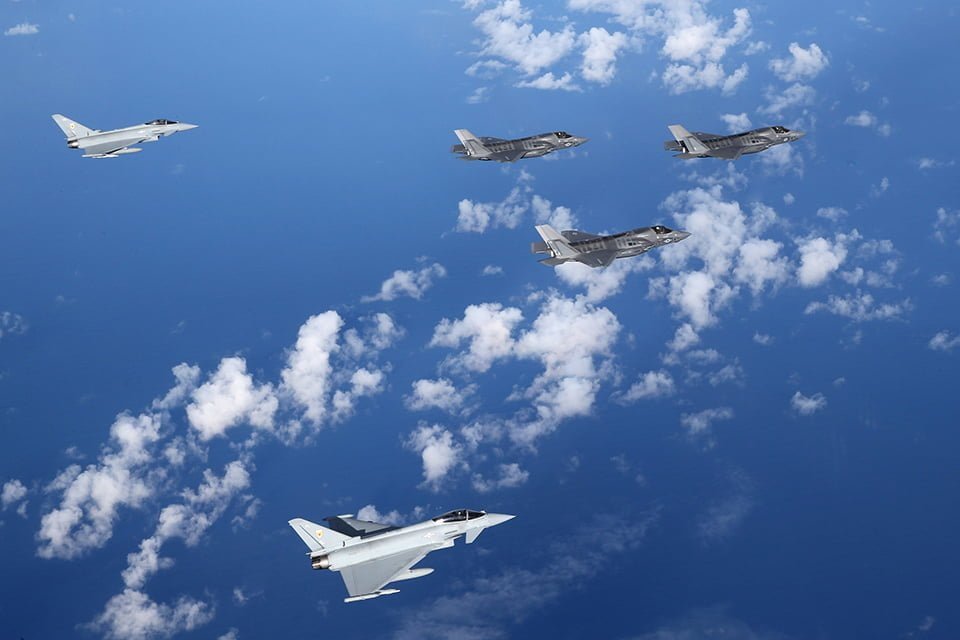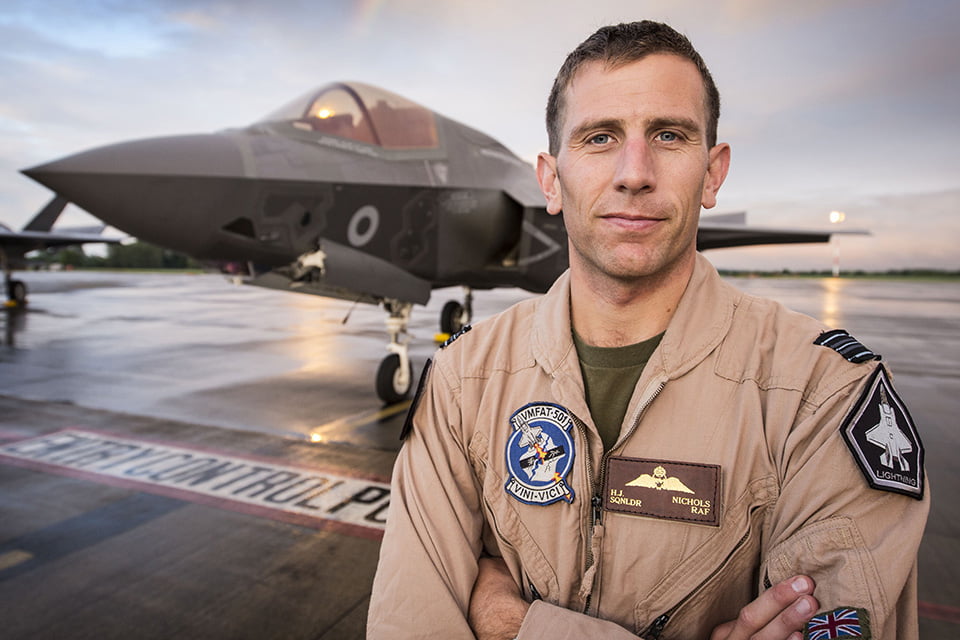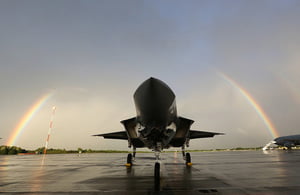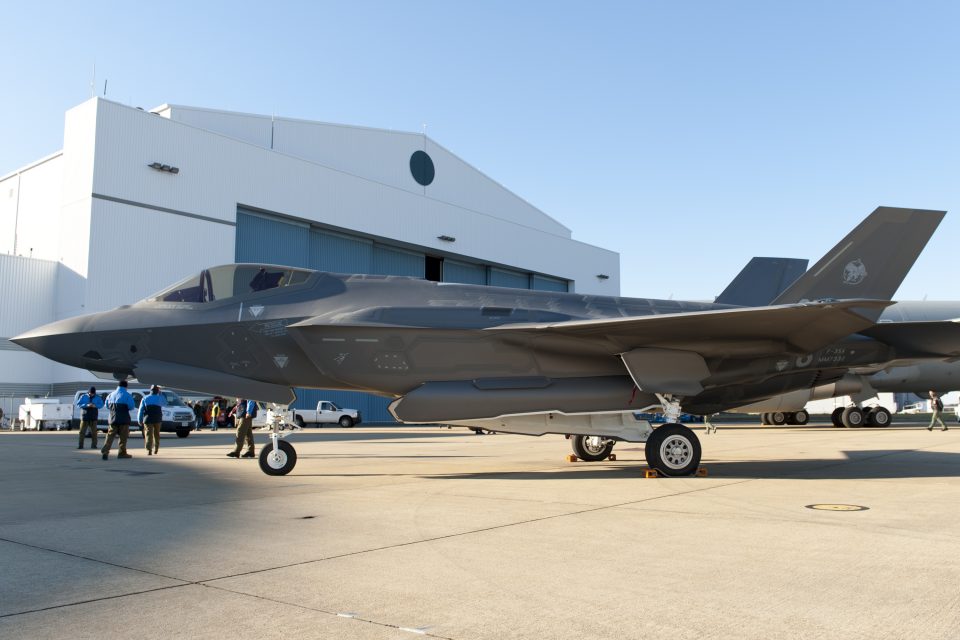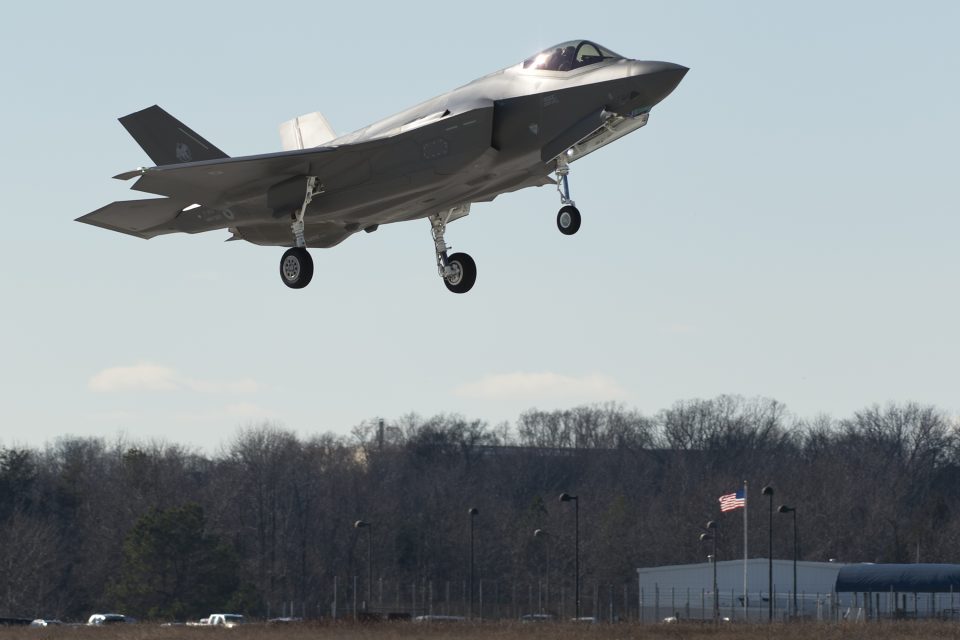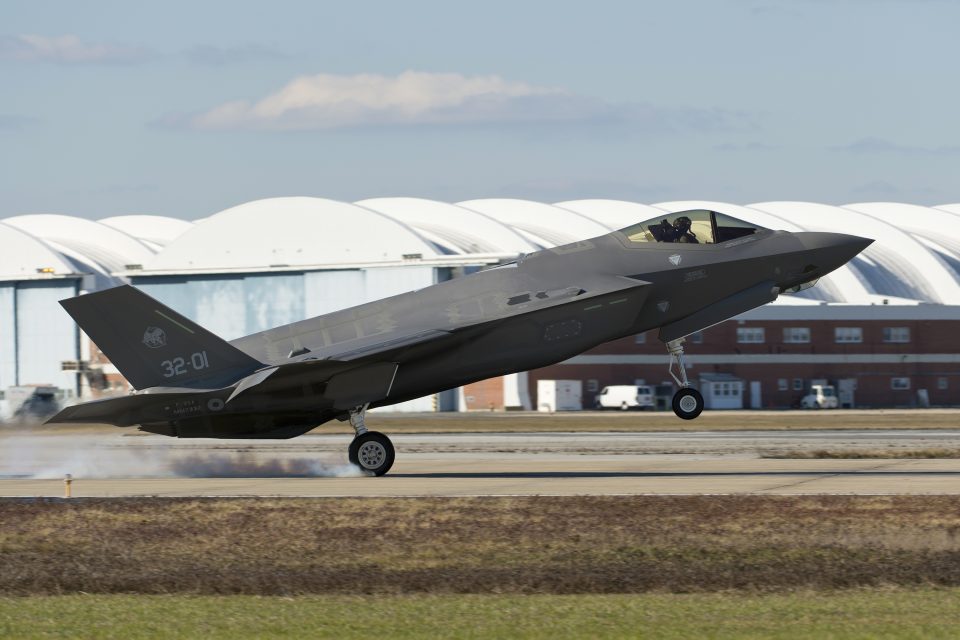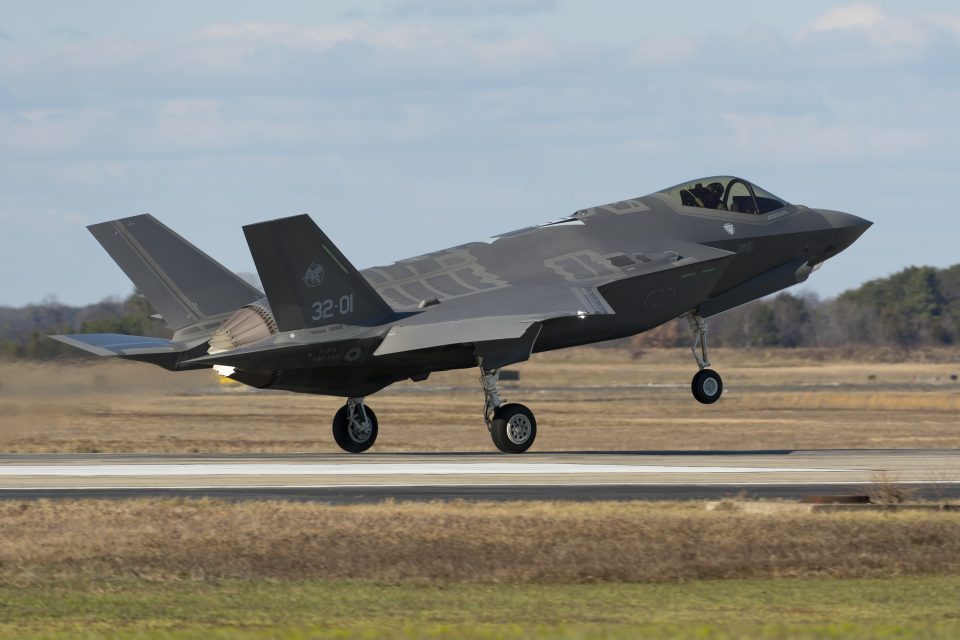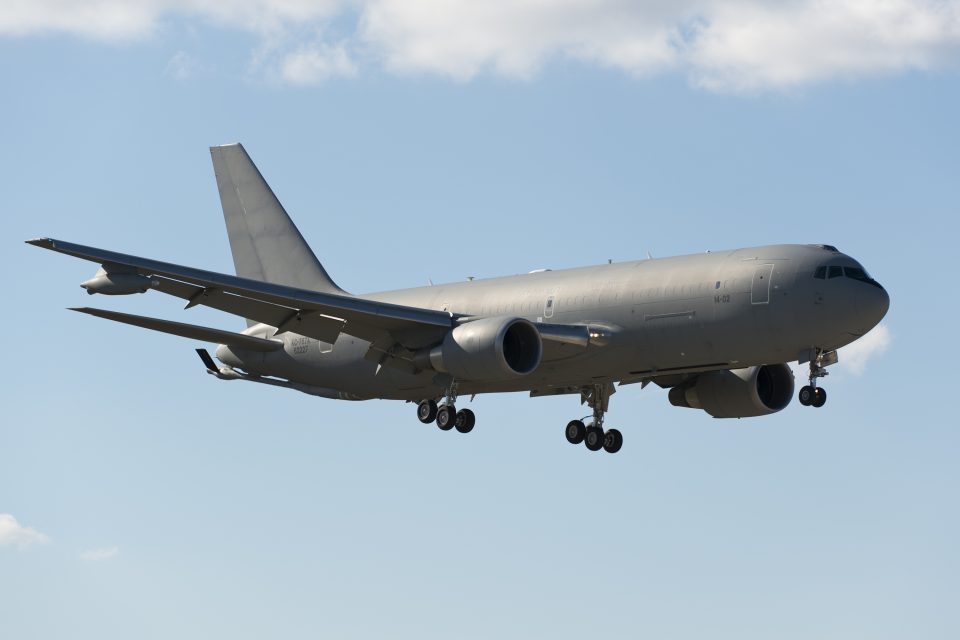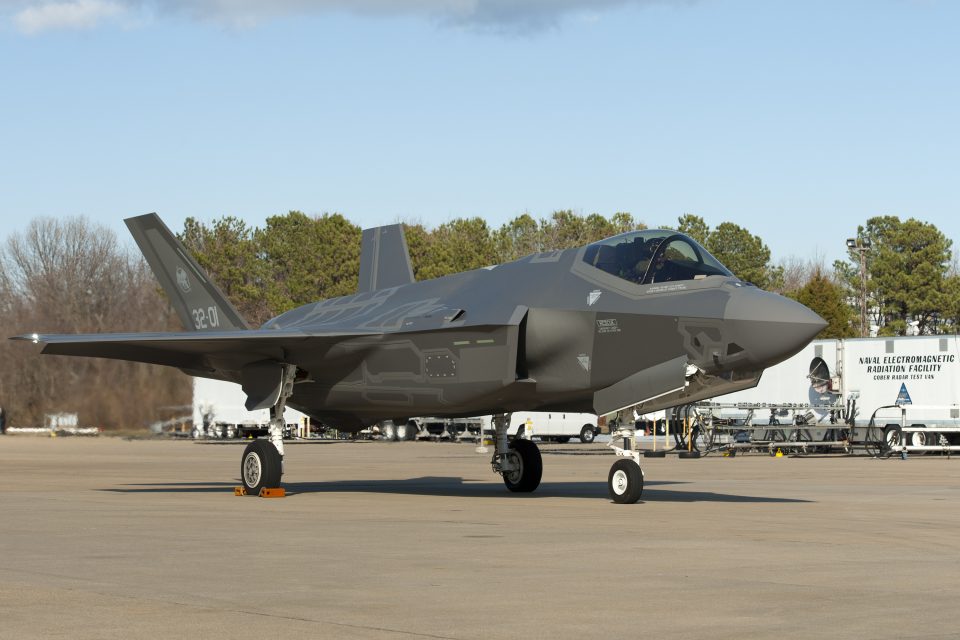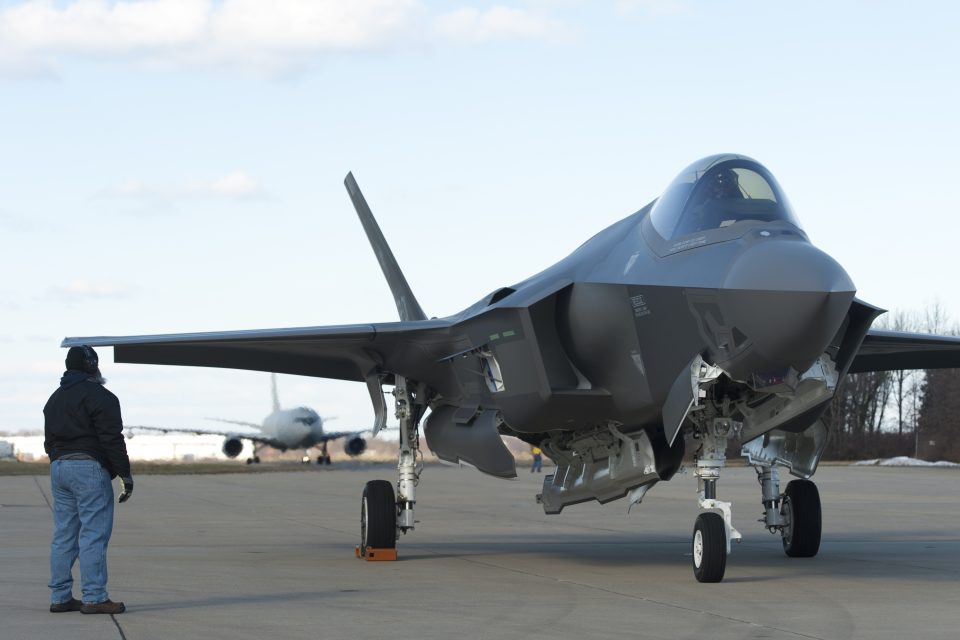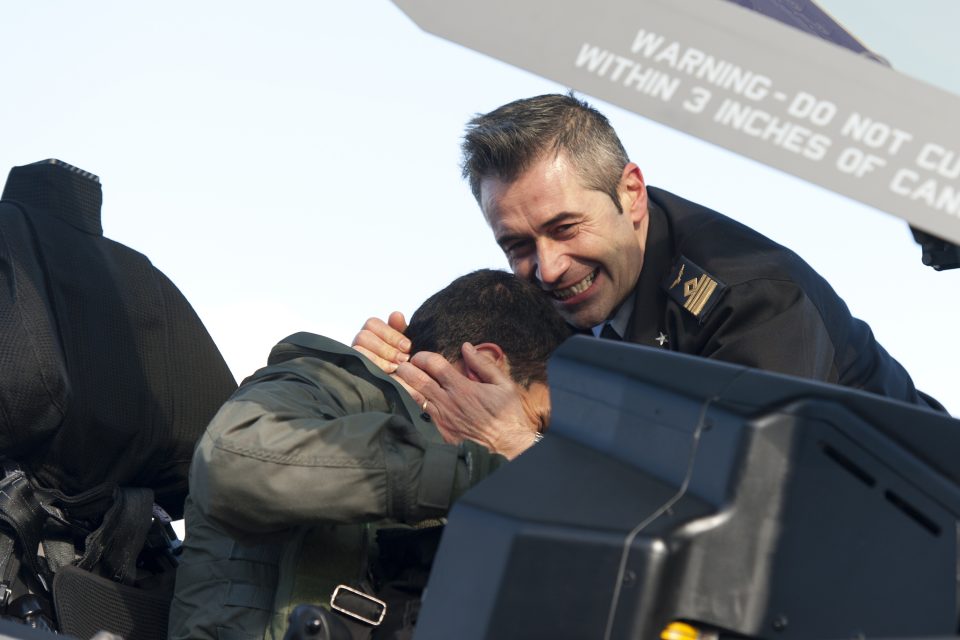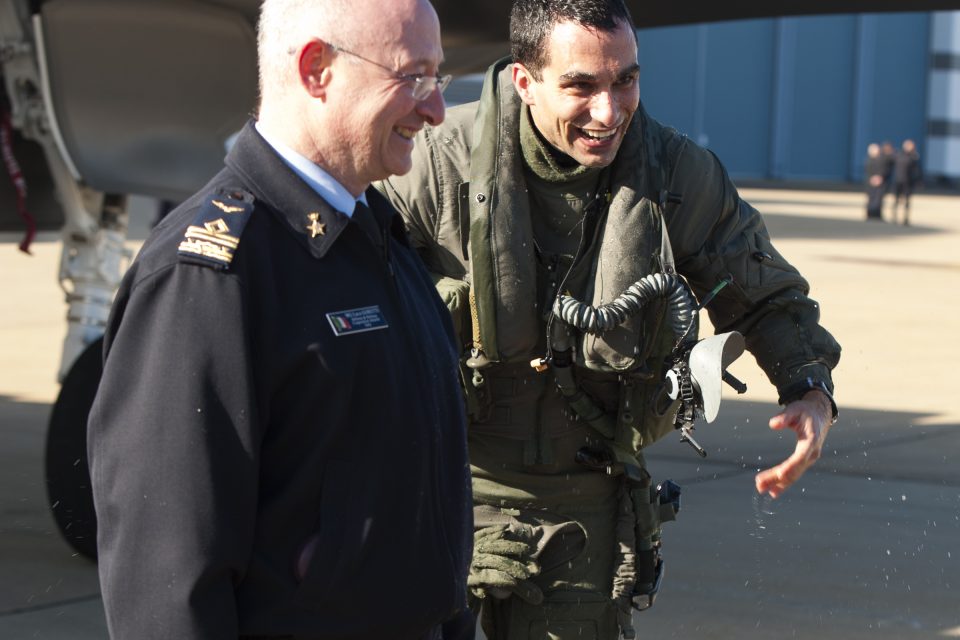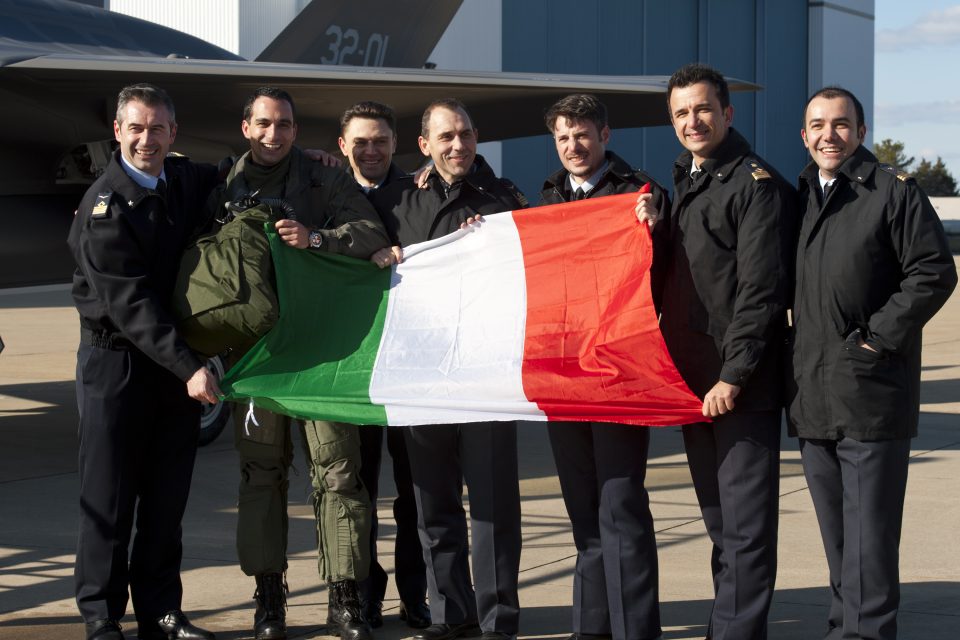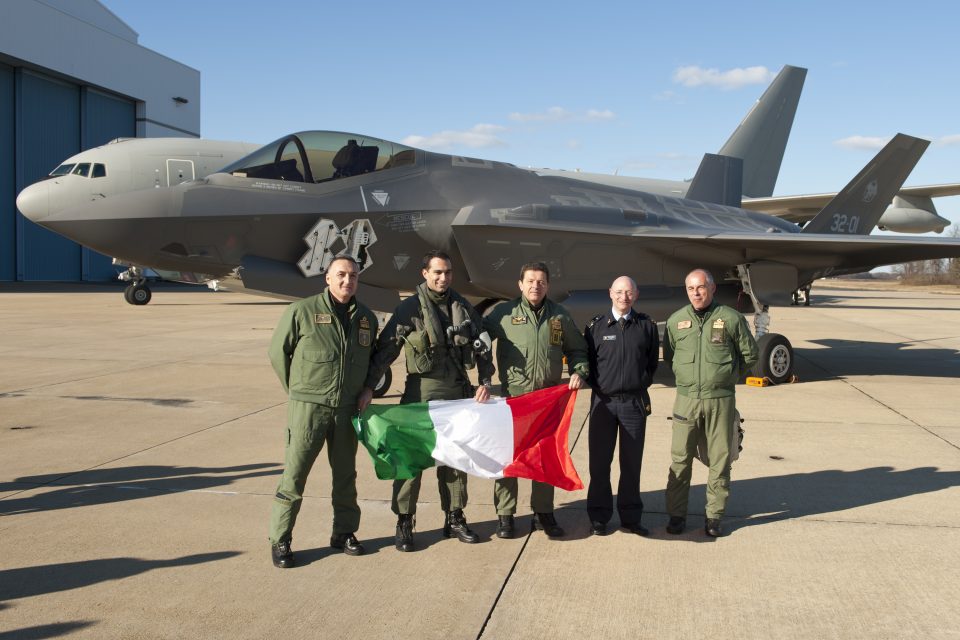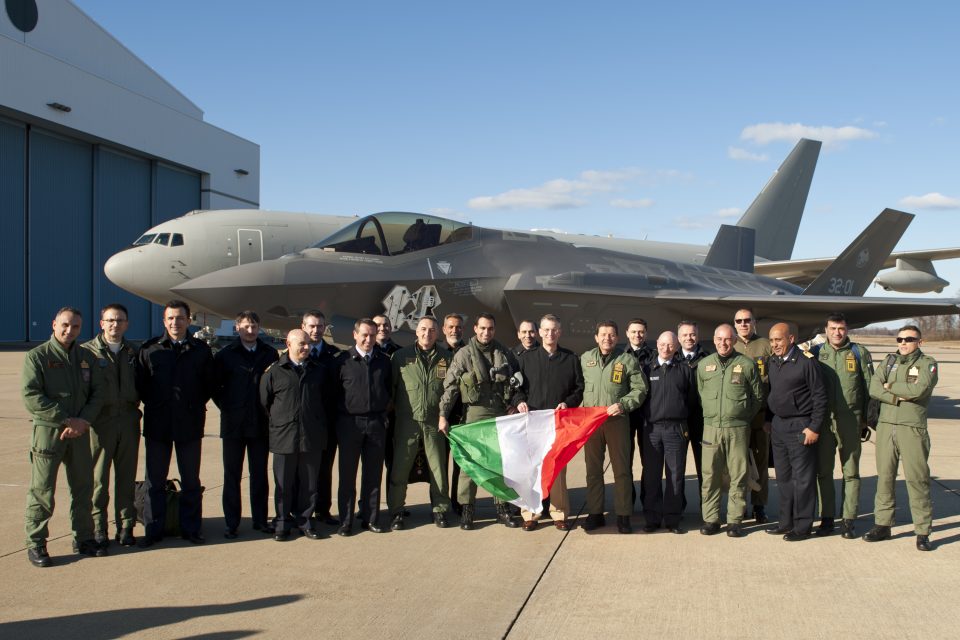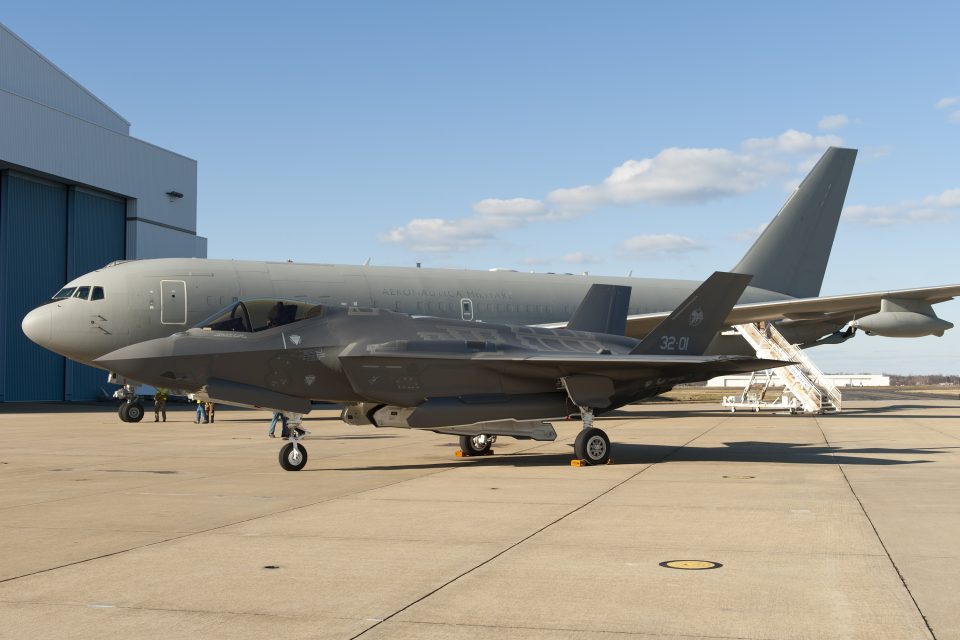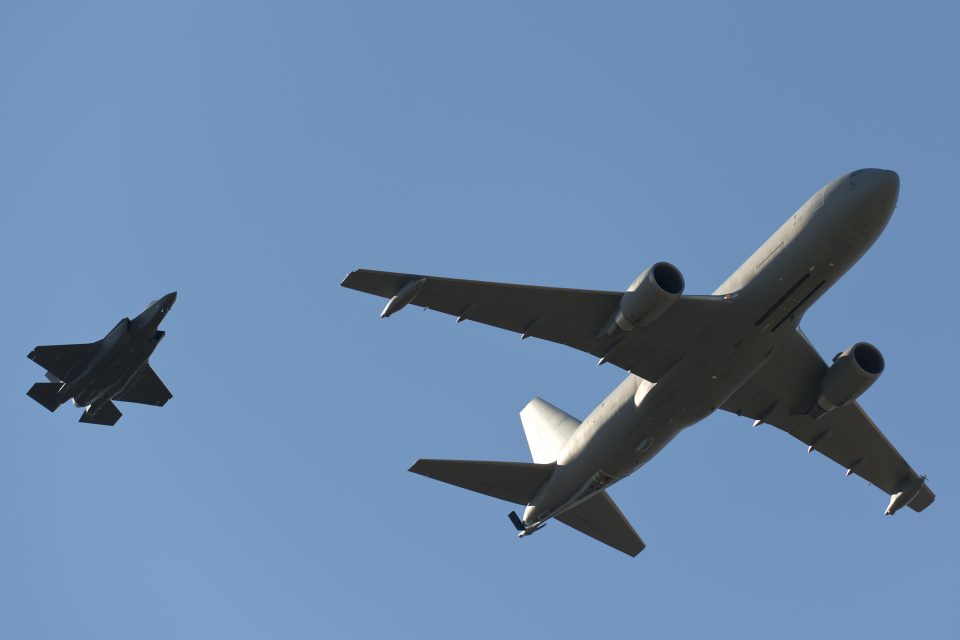2016-07-02 Although the arrival of F-35s for the Farnbourgh and RIAT air shows can be seen as a unique event, it is not.
It is part of a process of the coming of the F-35 to its initial operating capability, and starting a pattern of cross-Atlantic crossings.
Earlier, the Italian Air Force crossed the Atlantic with its F-35s built in Italy.
Next were the Dutch flying to the Netherlands for the first time from Edwards AFB.
And then the Marines and the RAF flew from USMC Air Station Beaufort to participate in the UK airshows at RIAT and Farnbourgh this summer.
Flying the RAF F-35B was RAF pilot Squadron Leader Hugh Nichols whom we interviewed last year at Beaufort.
At the Marine Corps Air Station, the Marines and the RAF are working the standup up of their individual capabilities but are doing so by building from the ground up in common.
The above video is credited to the UK MoD and the 2018 date refers to the UK IOC; the USMC jets are IOCd from last year.
According to a story on the UK MoD website published on June 30, 2016:
The first of Britain’s new supersonic ‘stealth’ strike fighters has touched down in the UK for the first time.
The F-35B Lightning II jet was flown by RAF pilot Squadron Leader Hugh Nichols on its first transatlantic crossing, accompanied by two United States Marine Corps F-35B aircraft from their training base at Beaufort, South Carolina.
The combined US/UK team of aircrew and engineers are here in the UK to demonstrate just what the 5th generation state of the art aircraft can do, flying at the Royal International Air Tattoo and Farnborough International Air Show over the next few weeks. The aircraft are due to enter service with the Royal Navy and RAF from 2018.
Defence Secretary Michael Fallon said:
The F-35Bs are the most advanced fast jets in the world. Whether operating from land or from one of our two new aircraft carriers, they will ensure we have a formidable fighting force.
They are part of our plan for a stronger and better defence: more ships, more aircraft, more troops available at readiness, better equipment for special forces, more being spent on cyber – to deal with the increased threats to our country.
Air Commodore Harv Smyth, Lightning Force Commander said:
The arrival of Lightning in the UK is an important step towards our delivery of operational capability with the UK’s first ever stealth fighter aircraft.
Operating from land bases or our new aircraft carriers, the F35B Lightning will provide ‘next generation’ advanced sensor capabilities which, when combined with its low observable, ‘stealthy’ design, allow the pilot to see more, know more and act faster than the enemy.
Our Lightning Force is developing very quickly and we are well prepared for the arrival of our first operational squadron (617 Sqn ‘The Dambusters’) at RAF Marham in 2018.
For our interviews with key players in standing up the UK F-35 capability, see the following:
https://sldinfo.com/the-new-uk-aircraft-carrier-reshaping-the-royal-navy-and-the-royal-air-force/
The photos in the first slideshow show the transit and arrival of the the Marine Corps and UK F-35Bs to the United Kingdom and are credited to the UK MoD.
The video above shows the USMC and RAF F-35Bs refueling during their 10 hour flight across the Atlantic.
Credit for Video: UK Defence Journal
PREPARING TO OPERATE OFF OF THE HMS QUEEN ELIZABETH: WORKING WITH THE MARINES AT VFMAT-501
Question: What is your function here at the squadron?
Sqn Ldr Hugh Nichols: I have two roles. I am an instructor pilot within the Warlords and in that role, I am an integrated member of the team.
My other role is as the Senior National Representative for the UK on the base here.
Question: At Luke the Aussies and USAF pilots are flying each other’s planes.
Is that happening here?
Sqn Ldr Hugh Nichols: It is. In effect, we have a pooling agreement here.
Our aircraft are pooled with those of the Marines, and we fly aircraft in the pool not just the UK jet.
Question: When you return to the UK with the planes, obviously a wider F-35 community is being established with which you will operate.
How do you see that?
Sqn Ldr Hugh Nichols: The majority of the operating areas big enough to fully utilize this aircraft will be out over the North Sea, so I can see us using this to our advantage by operating with our Northern European allies.
I would anticipate that there will be a lot of cooperation with Norwegians, Danes or the Dutch as we bring this exciting aircraft into service on European soil.
Question: And because the B and the A have common combat systems, your collaboration will not depend on which airframe you fly?
Sqn Ldr Hugh Nichols: That is correct.
At the end of the day, it doesn’t matter if you in an A, a B or C, once airborne, the mission systems are the same.
Question: What is the advantage of being here working with the Marines?
Sqn Ldr Hugh Nichols: There are many, but let us start with their sense of urgency in getting the aircraft to Initial Operating Capability.
The Marines have done a fantastic job working through previous program difficulties and have blazed a trail towards bringing this next generation capability into service..
They are Marines, and if anything gets in the way, they deal with it.
Working with them will clearly ensure that we are ready for the Queen Elizabeth.
And the pooling agreement is important in terms of cross learning.
Our young maintainers are working with Marine Corps maintainers and they are learning to work through different procedures and protocols to learn how to maintain a common airplane.
Question: Obviously, this will yield operational advantages later as Marines fly onto your ships and vice versa.
How do you see this?
Sqn Ldr Hugh Nichols: Obviously, deciding to do that is above my pay grade, but clearly you are right, we have cross-decked in the past and shaping commonalities from the outset will help us to so in the future.
The Marines could fly jets off of the Queen Elizabeth and we off the Wasp or other ships the USMC enable for F-35B use in the future.
Question: The RAF is in the throes of a modernization effort and necking down to a smaller type model series of aircraft across the board.
How are you working the Typhoon-F-35 integration?
Sqn Ldr Hugh Nichols: We have already started Typhoon-F-35 integration at Edwards, with the Test and Evaluation Sqns, and it shouldn’t’ be too long before we are involved in training exercises on the East Coast.
Question: Secretary Wynne made the point that modernization of legacy aircraft should be taken going forward from the perspective of working with the F-35.
How do you view that approach?
Sqn Ldr Hugh Nichols: It makes sense.
Each aircraft brings different strengths to the fight and we will fly them both, with the tactics will evolving over time.
Software modifications will undoubtedly be required in order to get the most out of each aircraft and ensure full interoperability; take Link 16 for example, where the F-35 could put out a huge amount of information.
We need to ensure that Typhoon is able to receive and display the information without overloading the pilot.
Question: Typhoons have flown for some time with F-22s and now with F-35s.
What is the impact on the Typhoon?
Sqn Ldr Hugh Nichols: It makes the Typhoon more lethal and survivable.
Today, every legacy aircraft that can fly with a Raptor clearly wishes to do so.
But there is going to come a point where they will prefer to fly with the F-35 due to the data linking capability of the F-35 and how that capability enhances the situational awareness of all aircraft in that fight.
For example, we can push information out to the legacy fleet so they know where the threats from integrated air defense platforms are and therefore they have a better understanding of where they are safe from those systems.
Question: What is the way ahead for the British presence at Beaufort?
Sqn. LDF Hugh Nichols: By 2018, we will have around 250 people here.
Then in 2018 we will move the squadron to the UK.
617 Sqn will fly home in mid 2018.
17(R) Squadron will remain at Edwards.
It is tasked to be involved in the ongoing operational tests as new software and new capabilities come online for the F-35 throughout its service life.
On May 19, 2015, a week before visiting the USS WASP and meeting with the crew and pilots doing the operational trials aboard the ship, the Second Line of Defense team went to MCAS Beaufort to discuss the progress made with the Warlords after moving from Eglin.
Credit Photos in the Second Slideshow Above: Second Line of Defense
The first few shots show some of the F-35s at the squadron that day, including one with Wasp markings that was prepared to join OT-1.
The sixth photo shows Squadron Leader Nichols in front of a UK F-35. Even though he is standing in front of the plane, within the squadron any squadron member might fly this plane, as will the Brits fly USMC jets. This is the same as at Luke where the Aussies and the USAF pilots fly each other’s planes. This is part of the F-35 global enterprise already being stood up.
The seventh and eighth photos show Murielle Delaporte with Squadron Leader Nichols and Major Brian Bann.
The final photos show Lt. Col. Bachmann and Major Bann with Murielle Delaporte and Robbin Laird in front of the Warlords squadron building.
And from the experience of flying the other way across the Atlantic in the middle of winter, we have the perspective of “Ninja.”
NINJA DISCUSSES HIS F-35 FLIGHT ACROSS THE ATLANTIC: THE RIGHT STUFF ITALIAN STYLE
Question: You flew in formation and through heavy clouds, we understand?
Answer: We had four aircraft total; and kept tight formation; and refueled in the clouds as well.
We had two C-130s just in the case; the tanker, a Typhoon headed to Red Flag and the F-35.
Question: So you were in a new aircraft, single engine, flying in the middle of winter across the North Atlantic in heavy headwinds?
Answer: That characterizes it.
Question: Did you hand fly the plane to stay in formation?
Answer: The plane is very reliable, and I hand flew some times, but auto pilot handled a great deal of the flight.
Question: What about the air refueling events?
Answer: We had 100% success even in the clouds; the big thing here is that the plane is very stable and reliable with no problems.
We had no disconnections; the F-35 is a very stable airplane.
Question: This is the first F-35 built on a new assembly line.
Did that come into play in your calculations in flying the aircraft?
Answer: We did 15 flight hours with AL-1 prior to crossing the Atlantic and we had no issues, and I mean NO issues.
It is the first F-35 built outside the United States.
Our workers at the FACO worked as a team as a team to get this result.
We are building for our own air force and wings for other air forces.
We flew the jet 5 times back to back to back to back prior to coming. I don’t think that has ever been done before as well.
Question: How many flight hours do you have on the F-35?
Answer: About 50 real flight hours.
I was formerly a Tornado pilot in the reconnaissance role.
And then became a test pilot.
Question: After the testing here, what is next for the jet?
Answer: We will take the first two aircraft to Luke AFB.
Then in a few months will bring additional aircraft to Luke.
This summer we will ferry number 4 and 5 to give us a full complement of five at Luke.
All the student pilots at Luke fly the aircraft in the fleet whether US, Australian, Norwegian or Italian.
And the training allows us to learn common TTPs from the ground up.
We are building a fifth generation approach from the ground up.
Question: When you sit in the F-35 cockpit and flew across the Atlantic how did the various systems assist you in the flight?
Answer: The great thing about the F-35 is that the human-machine interface (HMI) is so good and so built around the pilot that you don’t have to learn how it works.
You just use it.
You can configure the screens to configure for the mission.
The aircraft is built to understand; you are building a strategy, not focusing on managing the sensors or really focused on the flying function.
I was able to see the aircraft surrounding me through the clouds, such as keeping distance with my tankers, by using my helmet and the Distributed Aperture System and see the C-130s below me below the clouds.
Question: Did you have any problems with your helmet?
Answer: No. I used the Gen II helmet and the Gen III has improved the helmet, but my helmet worked flawlessly during the flight. I was able to fulfill the mission and I am here.
Question: How different is flying the Tornado compared to the F-35?
Answer: How can answer and be polite? There is no comparison. Recently, I flew the Tornado after learning to fly the F-35. It was a real shock to go back in time.
I had to move my head and focus on the switches and sensors – you have to manage the aircraft to fly.
The F-35 is totally different.
Question: What is it like to cross the Atlantic with DAS?
Answer: It is IR so much of its functionality is used during the night not the day, although you do look through your legs and could see buildings, intersections, and various landmarks while flying.
Question: Many more people saw Lindbourgh land at Le Bourget in 1927 than are here today.
There are four reporters here to witness your arrival, and let make no mistake about it, this is an historic day in which an Italian flew the first F-35A with an Italian assembled aircraft, rather than the USAF having done so.
How does that feel from an Italian point of view?
Answer: It feels great. It is a different mindset. We are working at a different level than we have done in the past.
It must be weird from your point of view to have an Italian fly the first F-35 across the Atlantic. We are making history. We are building it; we are flying it; we are maintaining it.
We talk about facts. I am a pilot.
We have flown all these flight hours with no problems; we are living a new reality.
The aircraft is extremely reliable.
We are close to 50,000 flight hours with aircraft.
That is a fact.
We had a no gripe, no maintenance discrepancies during flight as well.
Question: When the Marines we barred from flying from Pax River to the Farnbourgh air show in 2014, how did this affect your preparation and thinking?
Answer: I certainly realized that I was going to be first and felt that pressure.
But with regard to the flight I talked with the Marines about their flight – they went from Yuma to Pax – and their flight plan to come over.
They were very helpful.
Semper Fidelis is what I have to say about that.
Question: How was the airplane ergonomically?
Answer: I did not think about it until you asked the question.
The seat is very comfortable.
You can stretch your legs in front of you.
The helmet was confortable, and the seat was very supportable and comfortable.
With this helmet I do not have to turn my head, which makes it easier as well for the pilot.
Question: When did you learn that you would do this flight?
Answer: We started working this about six months ago and worked various scenarios for the flight including divert requirements if needed.
But the aircraft holds so much fuel that there is an additional safety factor built in. After 30 minutes after take off from the Azores I could reach the coast of Canada flying high. If I needed to fly lower, I would need a refueling.
We also brought our tankers to Edwards last year to do refueling of the F-35 and worked through various procedures and operating conditions.
Question: This plane is designed to drop bombs and fire missiles.
What you can see going forward with regard to training with regard to weapons?
Answer: It is a lot easier than you think.
This is one of the first aircraft that you can take off and after about two flights dropping bombs, and firing weapons.
Your mission systems are so good that you can start operating weapons very early in your training and operations.
We have to air-to-air pilots working with air-to-ground pilots and merging the cultures.
You are not focusing on your sensors; you are focusing on the end objective of your mission.
The big difference with this aircraft is situational awareness.
You see everything, and I mean on the surface and on the ground and you command attack, defense and electronic warfare functions within the aircraft.
The HMI is processing this and allowing you to be more strategic in your role.
You have different screens and different set ups that we are using as we fly the aircraft, and over time we can help the pilots standardize ways to usual the two screens optimally.
During my flight, I mostly used the two screens in the following way:
Half a screen provided a long-range view to look further; the second half showed the formation.
And the second screen contained my targeting Pod in one half and DAS in the other.
I hand flew because I wanted to play with the screens and figure out how to make best use of the systems during flight.
Question: How is the F-35 a game changer for the Italian Air Force?
Answer: The F-35 gives us much greater global reach.
We have so much gas in the aircraft and it is so fuel efficient, it gives us options in the various scenarios we are likely to face in our area of operations.
The photos in the third slideshow are credited to the Italian Air Force and Lockheed Martin and show the arrival of the Italian F-35s to Pax River on February 5, 2016.


